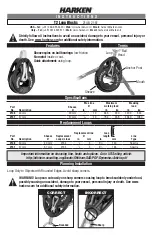
Intraoral Scanner User Manual
|
15
|
Separation distances
The
Intraoral Scanner
is intended for use in the electromagnetic environment in
which radiated RF disturbances are controlled. The customer or the user of the
Intraoral Scanner
can help prevent electromagnetic interference by maintaining a
minimum distance between portable and mobile RF communications equipment
(transmitters) and the
Intraoral Scanner
as recommended below, according to the
maximum output power of the communications equipment.
Table 2-5 Recommended separation distances between portable and mobile RF communications
equipment and the Intraoral Scanner
Rated
maximum
output
power of
transmitter
(W)
Separation distance according to frequency of transmitter
(m)
IEC 60601-1-2 : 2007
IEC 60601-1-2 : 2014
150 kHz to
80 MHz
d
= 1.2
√P
80 MHz to
800 MHz
d
= 1.2
√P
800 MHz
to 2.5 GHz
d
= 2.3
√P
150 kHz to
80 MHz
d
= 1.2
√P
80 MHz to
2.7 GHz
d
= 2.0
√P
0.01
0.12
0.12
0.23
0.12
0.20
0.1
0.38
0.38
0.73
0.38
0.63
1
1.2
1.2
2.3
1.2
2.0
10
3.8
3.8
7.3
3.8
6.3
100
12
12
23
12
20
For transmitters rated a maximum output power not listed above, the
recommended separation distance
d
in meters (m) can be estimated using the
equation applicable to the frequency of the transmitter, where
P
is the maximum
output power rating of the transmitter in watts (W) according to the transmitter
manufacturer.
NOTE 1:
At 80 MHz and 800 MHz, the separation distance for the higher frequency
range applies.
NOTE 2:
These guidelines may not apply in all situations. Electromagnetic
propagation is affected by absorption and reflection from structures,
objects and people.
The medical electrical equipment is suitable for the professional healthcare
environment per 60601-1-2:2014. It is suitable for use in physician offices, clinics,
hospitals, and other professional healthcare environments except near HF surgical
equipment and the RF shielded room of an ME system for magnetic resonance
imaging or other environments where the intensity of electromagnetic disturbances is
high.
The clinical environments where the device can be used include physician offices,
clinics, hospitals, and clinical point-of-care for diagnosis of patients except
environments where the intensity of electromagnetic disturbances is high.
















































